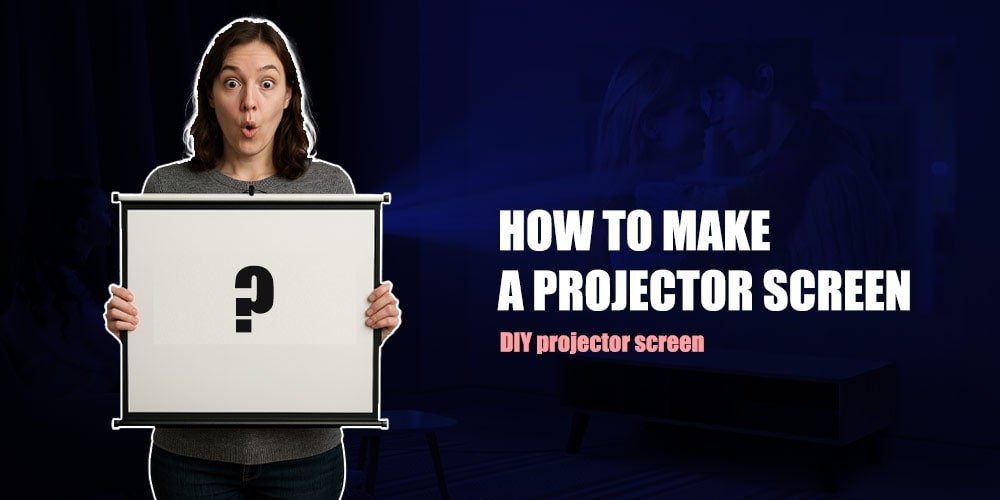Looking for ways to make projector screens at home? Here are three easy-to-make and effective screen ideas that will save your time, energy, and money.

Everyone likes to enjoy their favorite shows on a big screen, but not everyone has the budget and space for it. Suppose you have always desired to watch movies on a big projector screen, but do not have the money or space required.
This article is for you. Here, I have suggested three alternate ways to make a projector screen at home using everyday stuff that is readily available around you.
Easy to make a projector screen at home
- Free-standing screen made from pearlized Spandex and ¾” PVC
- The wall turned into a projector screen using non-reflective paint
- Lightweight hanging projector screen made of plywood and blackout cloth
Once you have selected the kind of screen you want for your projector, follow these steps that will help you make the screen without any hassle.
Free-Standing Screen made from pearlized Spandex and ¾” PVC
A projector screen made from pearlized Spandex and ¾” PVC is a perfect choice for people who want to build a screen that can be used both inside the house and outside. These screens come with a list of advantages.
- These screens can be used both indoors and outdoors.
- These screens are portable and easy to store
- The materials used to create such screens are pocket-friendly and readily available in any nearby hardware store
- These screens can be assembled back when needed effortlessly.
How to construct the top of the Frame?
Step-1 Take a pipe that is 5 feet long and link one end to a tee joint.
Step 2: Create a roughly 10-foot beam with the tee joint in the middle by taking a second 5-foot pipe and attaching it to the side of the joint that is directly opposite. Your Frame’s top will be created by this setup.
How to construct the bottom of the Frame?
Step 1: To make the bottom of your Frame, repeat steps one and two once more.
Step 2: Your top beam’s ends should be joined at a 90-degree angle.
Step 3: Each end of your bottom beam should be connected to a three-way joint.
Step 4: An end-to-end 5-foot pipe is used to secure the top and bottom beams. You now possess a rectangular structure that is around 10 feet by 5 feet.
Step 5: A 1-foot pipe should be attached to the top beam’s available tee junction slot. Ensure that the 1-foot pipe projects 90 degrees from the Frame.
Step 6: Make the bottom beam the same way.
How to provide support to the Frame?
Step 1: On the top beam, link your 1-foot pipe at a 90-degree angle with a 90-degree joint.
Step 2: Attach the 90-degree joint to the last 5-foot length of pipe.
Step 3: The 5-foot pipe should be joined to the bottom 1-foot pipe at a 90-degree angle. You now have back support for your Frame.
Step 4: Increase the Frame’s support by attaching the 2-foot pipes to the bottom beam’s accessible corners.
How to make the screen?
Step 1: Make the Frame ready for the screen by setting it in place.
Step 2: The pearlized Spandex should be folded once over on itself to make the screen.
Step 3: Fabric tape is used to create an envelope by joining the two sides. Ensure that the bottom is not sealed.
Step 4: For the seam edges to be on the inside, flip the Spandex envelope inside out.
Step 5: Over the top of the Frame, pull your Spandex screen. To prevent sagging, draw it snugly at the corners.
The wall turned into a projector screen using non-reflective paint
Turning their walls into screens seems to be the most convenient option for people who do not wish to spend extra on projector screens. All you need is a pencil, painter’s tape, sandpaper, primer, theatre screen paint, and dark non-reflective paint for the rest of the wall. A wall turned into a projector screen has its own set of advantages. Some of them have been listed below.
- Once you turn your wall into a projector screen, it becomes permanent.
- You don’t need to set up the screen from scratch whenever you wish to use the projector. All you need to do is turn the projector towards the wall. It saves a lot of time.
- You get a permanent projector screen without having to spend on accessories.
- These screens are highly cost-saving.
- They usually last longer than any other screens if properly maintained.
- You do not need any additional space when you create these screens.
Follow these steps if you wish to turn your room’s wall into a projector screen.
Step 1: To remove any lumps and flaws, sandpaper should be used to smooth the entire surface. Keep in mind you just need to fix minor imperfections, so start cautiously and proceed with prudence.
Step 2: To the entire wall, apply the primer. You might require two coats, depending on the primer you use. Attend to its drying.
Step 3: Determine the dimensions of your display space. Set up your projector where you want it to be and turn it on.
Step 4: Mark the required display area with a pencil and a long ruler once you are satisfied with the setup. Restarting your projector right now will help you make sure your display size is correct.
Step 5: Follow the pencil marks to outline the area inside the border’s boundaries with painter’s tape.
Step 6: The darker paint should be applied to the display area’s outside. Apply a second layer after allowing the first to dry.
Step 7: After drying, take off the painter’s tape.
Step 8: The display’s outer edges should be marked using painter’s tape. In order to prevent any gaps at the margins, make sure to completely cover the lines.
Step 9: Screen paint should be applied. Apply it gently, covering the entire area that has been chalked out, and treat it just like conventional paint.
Step 10: Carefully apply a second layer after the first has had time to dry. Hold off till it dries.
Step 11: The Painter’s tape must be taken off.
Step 12: Around the outside boundaries of the display area, carefully attach the velvet projector border tape. Any extra light will be absorbed with the aid of the tape.
Lightweight hanging projector screen made of plywood and blackout cloth
These screens are best for people who wish to use portable projector screens.
- These screens come with the following advantages.
- These screens are lightweight and easy to carry
- You can easily hang these screens and pull them down whenever you want to.
- These screens can be mounted anywhere
- The materials used to build this type of screen are readily available
- These screens are easy on the pocket.
The only disadvantage of making these screens is that you need adequate space to store them. They cannot be dismantled or reassembled once they are ready to use.
Steps to follow when you are constructing a hanging projector screen with plywood
Step 1: To make a 90-degree angle, align the 3-foot beam’s one end with the end of a 7-foot beam.
Step 2: To prevent the timber from splitting, drill pilot holes before screwing the beams together.
Step 3: Apply the same technique to the other end of the 7-foot beam. The 7-foot beam will now have 3-foot beams attached at each end.
Step 4: Create a rectangle-shaped frame by fastening the other 7-foot beam to the bottom.
Step 5: The final 3-foot beam should be attached in the middle of your Frame to add additional strength.
Step 6: In order to create the front of your display, place the blackout fabric across the Frame with the shiniest side facing up.
Step 7: Pull the blackout fabric as flat as you can, then affix it with two staples in the bottom beam’s middle.
Step 8 Apply the same technique to the upper beam, taking care to draw the fabric taut without tearing it. On each side of the Frame, repeat this procedure.
Step 9: At this point, the blackout cloth should be secured to the Frame with eight staples: two in the centre of the top and bottom, two in the centre of the left side, and two in the centre of the right side. Since you’ll need to clip the excess cloth, try to refrain from stapling too near the edges of the boards so you don’t have to trim too near the staples.
Step 10: The remainder of the material must now be fastened. Pulling the fabric taut, add staples on either side of the bottom beam’s initial staple. Repeat on the side and top beams.
Step 11: Work your way away from the first staples as you move around the Frame and continue this procedure. Always pull the blackout fabric tightly and only put two staples at a time. Continue doing this until the screen is tight all the way across and completely fastened.
Step 12: Cut off any extra blackout fabric.
Step 13: Cover the staples on the display area’s outer margins by applying the velvet projector border tape with care. A surplus of light will be absorbed with the aid of the tape.
Step 14: The picture hangers and cord should be attached after flipping the Frame over.
Step 15: Hang a picture hook from the wall. If you like, you could hang it from a fitting on a wall outside and watch movies there.
Conclusion: How to make a projector screen?
Therefore, I can say that there is no need to worry if you are looking for convenient options to build a projector screen and don’t have the budget for a ready-made screen.
You can either make a Free-Standing Screen made from pearlized Spandex and ¾” PVC, or you can turn your room’s wall into a projector screen using screen paint and non-reflective paint, or you can also construct a Lightweight hanging projector screen with the help of plywood and blackout cloth. These options are cost-effective, easy to make, and made from materials easily found in any hardware shop.
All you need to do is analyze your needs and pick the option that meets your requirements. If you still have doubts about how to make a projector screen, feel free to call me.
Related: How To Troubleshoot projectors?
